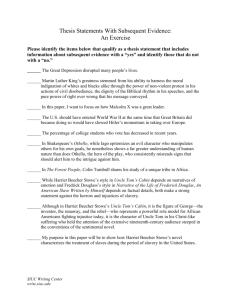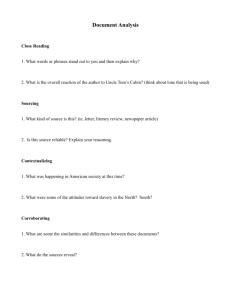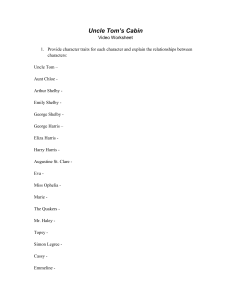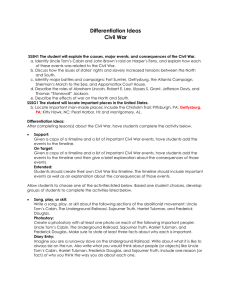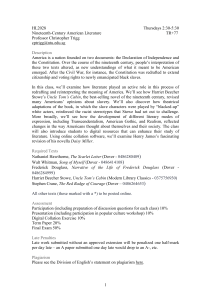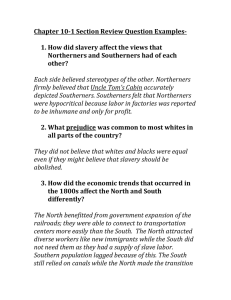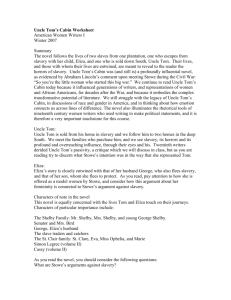Sources - adesocialstudiesplace
advertisement
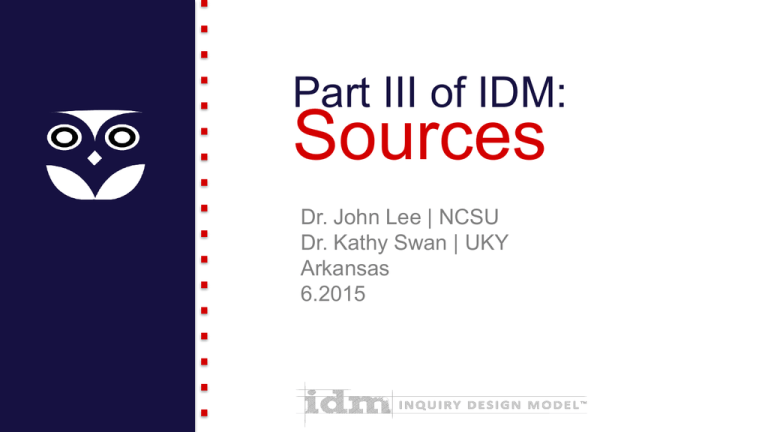
Part III of IDM: Sources Dr. John Lee | NCSU Dr. Kathy Swan | UKY Arkansas 6.2015 PartThis III: session Sources • What is the nature of sources? • What are sources? What makes a source disciplinary? What is the relationship between sources and tasks? How do sources support work with knowledge and skills? • What are the instructional uses of sources? • Spark curiosity/Build knowledge/Construct arguments • What should teachers think about when using sources? • Selecting sources/Scaffolding /Adapting sources This What aresession sources? What are sources? • Sources provide information that is useful in answering questions. • Three characteristics of sources – Information contained in a source – Composition of a source – Perspective or bias of a source What makes a source sessiondisciplinary? What makes aThis source disciplinary? • Sources have features that are distinctive within the disciplines. • Examples of disciplinary sources and processes include: Political Science – Legislation evaluating public policies Economics – Data and statistics quantitative reasoning Geography - Maps and GIS data spatial reasoning History - Oral history and diaries perspective Supporting Question 1 What is the relationship b/with sources & tasks? • IDM tasks are anchored by sources • Sources and tasks must work in tandem How did Harriet Beecher Stowe describe slavery in Uncle Tom’s Cabin? Formative Performance Task Summarize the plot of Uncle Tom’s Cabin, and identify main ideas and supporting details from Stowe’s description of slavery in Uncle Tom’s Cabin. Featured Source Source A: Summary of Uncle Tom’s Cabin Source B: Excerpts from Uncle Tom’s Cabin Source C: Illustrations from Uncle Tom’s Cabin Source work follows C3 Inquiry Arc If students are asked a COMPELLING question…… In the middle are the FORMATIVE TASKS (Content and Skills) Students answer in the form of a SUMMATIVE ARGUMENT Part II: What areInstructional the instructional Part II – The Usesuses of What makesThis source sessiondisciplinary? ofaSources sources? Sources can be used to: • Spark curiosity • Build knowledge • Construct arguments Sparking This session Curiosity Sparking Curiosity • Using sources for the purpose of curiosity & engagement. • Focus on relevance and what we know students care about. • Can be used throughout the tasks but often used within Staging Activities in IDM. Uncle Tom’s Cabin Inquiry “Words – so innocent and powerless as they are, as standing in a dictionary, how potent for good and evil they become in the hands of one who knows how to combine them.” American Note-Books of Nathaniel Uncle Tom’s Cabin Inquiry http://www.speaktruthvideo.com/2014-winners.html Kailash Satyarthi Discussion: Do you use sources to spark students’ curiosity? If so, how? If not, how might you start? Building ThisKnowledge session Knowledge Building • Sources in an inquiry contain the disciplinary knowledge (content and concepts) students need to complete tasks. • Students use disciplinary skills when building knowledge. • Students gather information from the sources during an inquiry. How do the sources support the building knowledge? Constructing This Arguments Evidence sessionwith Constructing Arguments w/ Evidence • Inquiries result in arguments. • Sources contain information that can be used as evidence in an argument. • Students need support determining what information should be used in an argument. How do the sources support the argument? Featured Source from 4th Formative Sources PartWorking III – Working Thiswith session with Sources • When using sources in an inquiry teachers should consider the following: – Selecting sources – Scaffolding – Adapting sources Selecting This session Sources Selecting Sources • Selection of sources requires deep knowledge of content. • Where can we find the sources? • Archives, libraries, collections • Online • Through collaboration and sharing • Students should encounter a variety of source Adapting sources Sources Part IIIAdapting – Working This session with Sources • Excerpting: using just a portion of the source. • Modifying: inserting definitions or changing words in the text. • Annotating: additional descriptions or notes added alongside the text. Discussion: Where do you stand with modifying, adapting, excerpting sources? Featured Source for Formative Task 1 Annotation Excerpt Summary: Fugitive slave Eliza is speaking with a friendly white woman who has taken her in after escaping Kentucky and crossing the Ohio River into the free state of Ohio. Eliza left after she found out that her master was going to sell her son Harry to an unscrupulous slave trader. Eliza and Harry are eventually joined by her husband George in Canada. "I have lost two, one after another,--left 'em buried there when I came away; and I had only this one left. I never slept a night without him; he was all I had. He was my comfort and pride, day and night; and, ma'am, they were going to take him away from me,--to sell him,--sell him down south, ma'am, to go all alone,--a baby that had never been away from his mother in his life!" Annotation Summary: In this illustration, Eliza comes to tell Uncle Tom and his wife Chloe, that Tom and Eliza’s son Harry have been sold to a slave trader. Eliza had just overheard the news from her master Mr. Shelby that the trader would arrive in the morning to take Tom and Harry away. In a panic, Eliza plans that night to run away. Sources require sources scaffolding Sources require scaffolding Part III Adapting – Working This session with Sources • Scaffolds provide novices with support for complex academic work. • Toolkit scaffolds were designed to support formative and summative tasks. • Analyzing sources in an inquiry involves literacy work. • Again, source work is not easy. Scaffolds throughout to help guide students reading 7th Grade Uncle Tom’s Cabin Inquiry Compelling Question New York State Social Studies Framework Key Idea(s) & Practices Staging the Question Can words lead to war? 7.7 REFORM MOVEMENTS: Social, political, and economic inequalities sparked various reform movements and resistance efforts. Influenced by the Second Great Awakening, New York played a key role in major reform efforts. Gathering, Using, and Interpreting Evidence; Chronological Reasoning and Causation; Comparison and Contextualization Consider the power of words and examine a video of students using words to try and bring about positive change. Supporting Question 1 How did Harriet Beecher Stowe describe slavery in Uncle Tom’s Cabin? Formative Performance Task Summarize the plot of Uncle Tom’s Cabin, and identify main ideas and supporting details from Stowe’s description of slavery in Uncle Tom’s Cabin. Featured Source Source A: Summary of Uncle Tom’s Cabin Source B: Excerpts from Uncle Tom’s Cabin Source C: Illustrations from Uncle Tom’s Cabin Summative Performance Task Taking Informed Action Supporting Question 2 What led Harriet Beecher Stowe to write Uncle Tom’s Cabin? Formative Performance Task Identify four quotes in the sources that point to Stowe’s motivation and write a paragraph explaining her motivation. Featured Source Source A: Uncle Tom's Cabin- Chapter XLV: Concluding Remarks by Harriet Beecher Stowe Source B: Letter from Harriet Beecher Stowe to Lord Thomas Denman, 1853 Supporting Question 3 How did Northerners and Southerners react to Uncle Tom’s Cabin? Formative Performance Task Compare the viewpoints expressed in Northern and Southern newspapers using a Tchart and make a claim about the differences. Featured Source Source A: The Morning Post "W. B. S." Boston, May, 1852 Source B: Southern Press Review, Unsigned, 1852 Questions Supporting Question 4 What was the impact of Uncle Tom’s Cabin on abolitionism? Formative Performance Task Participate in a structured discussion regarding the impact Uncle Tom’s Cabin had on abolitionism. Tasks Featured Source Source A: Charles Sumner quote from the Senate, 1852 Source B: The Liberator John Ball, Jr. Boston: 8 September 1854 Source C: Sales of Uncle Tom’s Cabin Can words lead to war? Construct an argument (e.g., detailed outline, poster, essay) that discusses the impact of Uncle Tom’s Cabin using specific claims and relevant evidence from historical sources while acknowledging competing views. Understand: Identify and describe a modern issue that needs reform (e.g. child labor, trafficking, or poverty). Assess: Create a list of possible actions that involve words. This may include letters, editorials, social media, videos, and protests. Act: Choose one of the options and implement it as an individual, small group, or class project. Sources Summary Sources of require Session sources scaffolding 3: Sources Summary: Sources Part III Adapting – Working This session with • IDM features three instructional uses of sources. – Sparking curiosity, – Building knowledge, and – Constructing arguments with evidence. • When using sources in an inquiry teachers should consider the following. – Selecting sources – Scaffolding – Adapting sources IDM Lab™ Your task • Find a source that would help stage your compelling question. • Find “featured sources” to help support your formative performance tasks. – Ask yourself: What sources would help students become curious, build background knowledge, construct arguments? • Modify/Excerpt/Scaffold sources to better engage students. • Use the IDM Quick Guide to Gathering and Using Disciplinary Sources.
